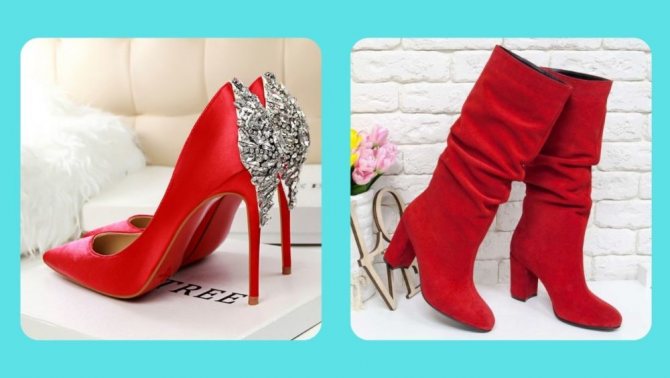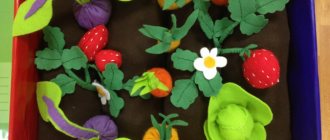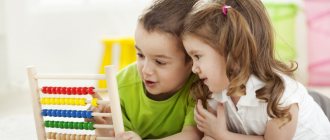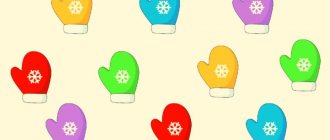Collection of didactic games
"Cars"
There are long and short strips of the same width on the table
The teacher invites the children to take one strip each. These are the “numbers” of the cars. And the gates are garages. Let the guys imagine that they are all “cars”, each with their own “number”. "Cars" will drive around the city. But as soon as the presenter says: “Cars, go to the garage!” - everyone must find their own garage and move into it. To do this, you need to attach the “number” of your car to the “number” on the gate. If the “numbers” are the same in length, you can move in.
During the game “Cars”, show the children an illustration. Ask them questions to help them make sense of what is happening.
The game is repeated 2 times.
"Merry dolls"
Purpose of the game: to teach to distinguish and compare objects according to different qualities of quantities.
Equipment: 2 sets of five-seater nesting dolls, 2 sets of circles of different sizes, a tower made of hollow cubes.
Progress of the game: At the invitation of the teacher, the children sit at a common table on which there is a nesting doll. The teacher turns to the children: “I want to play funny nesting dolls with you, but I see that there is only one nesting doll here, but where are the rest? (looks around, and then picks up a matryoshka doll and shakes it). Something is rattling in the middle! Let's see what's there? (Removes the upper half of the matryoshka doll). This turns out to be where they hid! (All nesting dolls are placed in a row). Let's get to know them! The teacher calls the name of each doll, tilting it: “I am Matryosha, I am Natasha, I am Dasha, I am Masha,” etc. Each child chooses one of the nesting dolls (the teacher takes one matryoshka for himself). The game begins. First, the nesting dolls walk (walk on the table). Then they are called to measure height. They line up one after another and take turns, starting with the smallest one, standing according to height, and the teacher clarifies which nesting doll is the smallest (tallest)? Then the nesting dolls go to dinner. The teacher puts on the table a set of circles (plates) of five sizes, calls the children in turn, who select plates of the appropriate size for their nesting dolls. After lunch, the nesting dolls get ready for a walk. The teacher puts the second set of nesting dolls on the table, and the children select girlfriends of the same height for their nesting dolls. Pairs of nesting dolls move around the table. Then they run away and mingle. (“The nesting dolls wanted to run”). Unnoticed by the children, the teacher removes a pair of nesting dolls of the same height from the table. "Time to go home! - says the teacher. Get into pairs." The nesting dolls are lined up in pairs, and suddenly it turns out that a certain pair of nesting dolls is missing. The teacher invites the children to call the nesting dolls by name (if they remember). Everyone asks her to come back in unison. The nesting dolls appear, the kids put them in place and the toys go home. The teacher places on the table a tower made of hollow cubes (one side is missing) - these are houses for nesting dolls. At the request of the teacher, each child finds a home for his nesting doll. The nesting dolls bow, say goodbye and go home.
New Year's geometric games for children of the younger group
New Year's geometric games for younger preschoolers
This material will help in a fun way to consolidate knowledge about geometric shapes, develop elementary mathematical concepts of preschoolers, consolidate knowledge of color names and counting skills.
The material may be useful to educators, parents, additional education teachers, and speech-language pathologists. Goal: consolidate knowledge about the shapes square, circle, triangle. Objectives - Develop visual perception - Teach children to differentiate shapes, name them correctly - Strengthen counting skills - Strengthen knowledge of the names of colors - Improve fine motor skills - Develop patience, diligence and accuracy in work Equipment: pictures with snowmen, Christmas trees with drawn figures, cardboard figures, figures from geometric sets, clothespins The work presents three games “Snowmen Decorate Christmas Trees”, “Snowmen Search for Figures”, "Christmas trees with figures."
Game “Snowmen Decorate Christmas Trees”
Game progress: Show children pictures of snowmen.
Teacher:
“Guys, look who came to visit us today... These are snowmen! Everyone has a smart hat, scarf and mittens of the same color. This one is blue, this one is red, this one is orange, and this one is green...(put a box of clothespins on the desk) Let's make legs for our snowmen from clothespins of the same colors. This is the left leg (we attach a clothespin and show it). And this is the right leg. Look, now our snowman can stand... and now try it yourself - find clothespins of the same color (students do it themselves, we place the snowmen on the desk)

Teacher:
“What beautiful snowmen we have made!
Guys, do you remember what holiday is coming soon? That's right, New Year! The snowmen decided to decorate the Christmas trees beautifully, and their Christmas trees are not simple, but with different figures (we show pictures with Christmas trees) On this tree there is a circle, a square and a triangle, and on this one which ones? (children show, name the figures) Teacher:
“Everyone has The snowman has his own favorite color. Guess what the first snowman’s favorite color is? (we attach a clothespin to the top of the tree, the children name the color, and decorate other trees in the same way)

Teacher:
Let's help our snowmen decorate the Christmas trees beautifully - we will look for figures of the same color as the top (we put a box with cardboard figures on the desk, students select the figures by color and shape. After all the trees are decorated, we match the Christmas trees and snowmen that match color, pronounce the names of shapes and colors)

Teacher:
Guys, these are the beautiful Christmas trees you got. How many Christmas trees have we decorated? Let’s count (lay out the numbers, recalculate) It turns out to be four. how many snowmen? As many. This means that there are equal numbers of Christmas trees and snowmen.

Game "Snowmen looking for shapes"

Teacher:
Guys, each of the snowmen has a favorite figure, the first has a circle, the second has a square, the third has a triangle. Let's help the snowmen collect the same figures as they have in the pictures (we lay out a box with a geometric constructor, the children sort the figures on their own. We name the color and shape, at the end you can count the figures, compare which figures are more, which are fewer. You can build from different figures house, Christmas tree, car

Game “Christmas trees with figures”
Game progress. We show children Christmas trees with painted figures.

: Guys, look at the Christmas trees I have, and each one has different toys - here are round, here are square, and here are triangular. Let's beautifully decorate each Christmas tree with suitable figures (children select the figures, name the colors and shapes)

I use these games in FEMP classes with children 3-4 years old with mental retardation. Thank you for your attention!
We recommend watching:
Didactic games in mathematics for preschoolers 3-4 years old Didactic game “Let’s decorate the Christmas tree” for children 3-4 years old Didactic game in mathematics in the second junior group Game travel in mathematics in the younger kindergarten
Similar articles:
New Year coloring pages for children 3-4 years old
Tasks for children 3-4 years old in pictures
Mathematics assignments in pictures for children 3-4 years old to print
Compare items
The didactic game “Compare Objects” develops the ability to think logically and construct coherent and grammatically correct speech. To carry it out, prepare several pairs of cards. Each pair should depict items belonging to a specific category, for example, clothing, seasons, flowers, fruits, transport.

There are 2 game options:
- Individual. Place a couple of cards in front of the player. The child examines them carefully, looking for how the depicted objects are similar and how they differ. The player must give detailed answers and form phrases. For example, a lemon and an orange are depicted. The child explains that these are fruits. Both fruits are similar in that they are juicy and consist of segments. They differ in that lemon is sour, yellow, oval, and orange is sweet, orange, round.
- Competitive. Place a pair of cards in front of two players. Children look for similarities and differences, as in the first version of the game, but they do it in turns. Here, too, it is important to control that children give detailed and competent answers. The player who names the most correct comparative features wins.
Here are examples of paired images for the game:
- apple - pear;

- violin - guitar;

- currants - grapes;

- shoes - boots;

- cloud - cloud;

- Panama - hat;

- sweater - T-shirt;

- winter summer;

- boat - motor ship;

- mug - pan;

- the horse is a zebra.

Compare geometric shapes
The game forms preschoolers' initial geometric knowledge and develops the skill of logical and visual analysis of the arrangement of figures. To carry it out, make a set of pictures of geometric shapes. Also draw one or more tables, depending on the number of players, with cells corresponding in size to the images of the figures.
Arrange the shapes in the cells in a certain order. Leave one of the cells empty. Invite the player to identify a pattern in the way the pieces are laid out. Based on this, select the correct geometric image for the empty cell.
The game can be made competitive by distributing the tables to several children. The winner is the one who is faster than the rest and completes the task correctly.
Game "Compare"
The purpose of the didactic game “Compare” is to teach direct counting to 10 and counting backwards.
Tasks:
- forming an idea of the composition of numbers;
- teaching numeracy;
- familiarization with the mathematical concepts “<”, “>”, “=”;
- learning to solve primitive mathematical problems;
- development of memory and attentiveness;
- developing teamwork skills;
- nurturing interest in learning.
For the game, prepare cards, each of which depicts objects in two columns in a certain number from 1 to 10, the same or different. Also make cards representing the math symbols "<", ">" and "=".
The game can be organized as an individual or group game. The student, having received the card, counts how many objects are depicted in the right and left columns. Having made a conclusion about the number of objects, he takes the corresponding mathematical symbol and places it between the columns.

Compare three figures
The game is designed to develop comparison skills. To carry it out, take logical blocks.
Mix the shapes and place them in random order. Take the first two and place them in front of the students. The first player takes the next block and places it next to the first two pieces. Then he carefully examines it, trying to determine whether the figures have common parameters: size, shape, color. If there is, the player takes all 3 blocks for himself. If the figures are not similar in any way, then the last block must be placed at the end of the main arbitrary row.
The next player continues the comparison, takes the next block from the beginning of the row, and compares it with the other two. If the similarity is found not by the player who has the move, but by his opponent, then the second one takes all 3 pieces. The one who has the most logical blocks wins the game.






